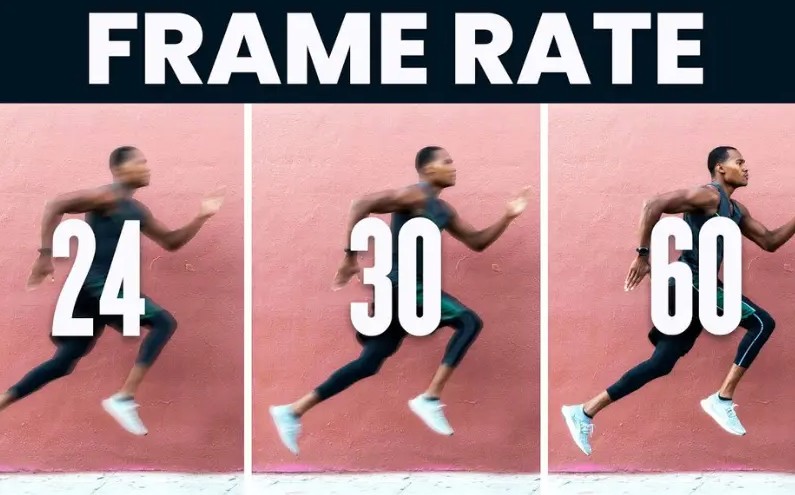Best Selling Products
Frame Rate is the number of frames displayed in a unit of time, usually one second.
Nội dung
Frame Rate is the number of frames displayed in a unit of time, usually one second.

Frame rate is the “skeleton” behind every fast-forward or slow-motion scene in the movies and videos you watch every day. However, not everyone really understands what Frame rate is, as well as the parameters 1–16 FPS, 24 FPS, 30 FPS, 60 FPS or 120+ FPS mean and how they are applied. In this article, SaDesign will explore with you the basic concepts and common parameters in Frame rate, so you can be more confident when choosing settings for your videos, animations or games.
1. What is Frame Rate?
Frame Rate is the number of frames displayed in a unit of time, usually one second.
The unit of Frame Rate is FPS (Frames Per Second). For example, a video with 30 fps means that in every second, the video displays 30 frames. The frame rate determines how smooth the image in a video, game or other media is. The higher the fps, the smoother and more natural the motion in the video will appear.
2. The importance of Frame Rate
Frame rate is an important factor that affects the quality of video playback. Live videos or videos with a lot of movement, such as sporting events, often have high frame rates because there are many events happening at the same time. A high frame rate means there are more frames per second, resulting in smoother video playback.
.png)
When streaming video, your device needs to decode and display each frame in real time. Therefore, the smoothness of the video also depends on the capabilities of the streaming device because it needs to be able to support that frame rate. For example, if the frame rate is 30 fps and your device only supports 24 fps, the video quality will not be as smooth as expected.
3. How to adjust Frame Rate parameters effectively
Now that you understand what frame rate is, how do you adjust the frame rate accordingly? Each frame rate has a specific use. The best frame rate will depend on your content, your video settings, and the overall effect you want your content to have.
The most common fps values in video production are 24 fps, 30 fps, and 60 fps. Here are some familiar frame rate parameters in the video production field.
16 FPS
Compared to the popular fps levels today, 16 fps is considered relatively low and is rarely used. At this speed, the video movement will not be smooth and can cause lag. However, if you want to shoot a retro-style video, you can shoot at this speed to create a nostalgic, classic feel.
24 FPS
24 fps is a common frame rate in the film and video production industry. 24 fps is considered the standard for feature films, with the goal of creating a smooth and realistic viewing experience for the audience. This frame rate is often considered to create a “cinematic feel” to video, with motion and images appearing smooth and natural.
.png)
30 FPS
Some cameras can shoot video content at 30 frames per second for TV shows, sports, or live broadcasts. Some content creators also choose 30fps because it maintains video quality and file size remains reasonable.
60 FPS
60 fps is an option that many gamers use when playing fast-paced games to keep up with rapid movements. When recording fast-moving events or activities, such as sports or outdoor activities, a 60 fps frame rate helps capture more accurate and smooth details.
Additionally, 60 fps can be used in some special cases in cinema. Shooting footage at 60 FPS allows the editor to create smoother slow motion effects by slowing down to 24 fps or 30 fps. For action scenes, 60 fps can also be used to create motion effects.
120 FPS and higher
High frame rates like 120 FPS are often used for slow-motion (slo-mo) video. With a higher frame rate, you can edit videos and slow down scenes with more flexibility, allowing you to create special and subtle motion effects. However, using higher frame rates also requires support from the right equipment and software.
4. How to choose the right FPS
Choosing the right frame rate depends on many factors. The most important aspects to consider are:
.png)
Purpose of content
First, consider the content of the video and its purpose. The frame rate for recording a video game and slow-motion video will be different. Or the frame rate for a feature film will be different than for a live TV broadcast. So it's important to determine the purpose of the content before you start recording.
Device capabilities
Real-time frame decoding and rendering is the second and most important factor that affects frame rate. This is the video processing that involves decoding the compressed frames in the video file (decoding) and then displaying them on the screen (rendering).
The higher the number of frames per second, the smoother the video. Conversely, if your device cannot decode and display each frame, the video will appear choppy. Therefore, the frame decoding process needs to happen quickly enough to ensure that the video plays smoothly and without stuttering.
.png)
Motion in video
Motion in a video is the third important factor that affects the choice of video frame rate. Each frame in a video is a single still image. To create a smooth motion effect, these frames need to be displayed consecutively at a certain rate. The more motion, the higher the frame rate required.
If the video has a lot of motion (i.e. objects change position a lot between frames), the frame rate needs to be higher to ensure the motion looks smooth. For example, high-speed car races require a higher frame rate than regular videos. So before you choose a frame rate, make sure you know what kind of motion you want to see in your video.
Internet speed
Internet speed is an important factor in determining the appropriate frame rate. Streaming requires a fast internet connection to provide a smooth viewing experience. Conversely, a slow internet connection can result in video stuttering, buffering, and frame loss, which significantly reduces the video quality. An unstable internet connection also cannot support high frame rates.
Through the above article, SaDesign has explained to you what frame rate is and introduced some common fps values. There is no concept called the best frame rate, it depends on the type of content, purpose of use and specific requirements of each case. Hope you have got useful information, don't forget to share and see you again in the next articles!












































